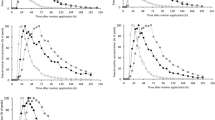Abstract
The dry matter content of 245 faecal samples of 81 species of captive wild ruminants was investigated. Samples were taken from 10 different zoos from temperate climate during the winter months. All animals hadad libitum access to drinking water. Species were classified as frugivores (FR,n=5), browsers (BR,n=16), intermediate feeders (IM,n=35), and grazers (GR,n=25). While no difference was observed in the average faecal dry matter content between the feeding types, the range of dry matter contents increased continually from FR, BR, IM to GR, ie both the driest and the wettest faeces of this study were produced by grazing ruminants. As it has been shown that faecal dry matter content is a function of the length of the colon descendens of a ruminant species, these results can be interpreted as an indication of a relatively limited variation in anatomical design in this respect in the evolutionary older FR and BR, and a relatively larger variation in anatomical design — and probably niche adaptation — in IM and GR. This corresponds to the greater range of habitat niches that IM and GR manage to occupy. Due to this increased variation in the anatomical design of the lower hindgut, GR are regarded as «morphophysiologically progressive ruminants», in contrast to BR which are regarded as «morphophysiologically conservative ruminants».
Similar content being viewed by others
References
Clauss M. and Lechner-Doll M. 2001. Differences in selective reticulo-ruminal particle retention as a key factor in ruminant diversification. Oecologia 129: 321–327.
Clauss M., Lechner-Doll M. and Streich W. J. 2002. Faecal particle size distribution in captive wild ruminants: an approach to the browser/grazer-dichotomy from the other end. Oecologia 131: 343–349.
Clauss M., Kienzle E. and Hatt J. M. 2003a. Feeding practice in captive wild ruminants: peculiarities in the nutrition of browsers/concentrate selectors and intermediate feeders. A review. [In: Zoo animal nutrition Vol. II. A. Fidgett, M. Clauss, U. Ganslosser, J. M. Hatt and J. Nijboer, eds]. Filander Verlag, Fürth, Germany: 27–52.
Clauss M., Lechner-Doll M. and Streich W. J. 2003b. Ruminant diversification as an adaptation to the physicomechanical characteristics of forage. A reevaluation of an old debate and a new hypothesis. Oikos 102: 253–262.
Clauss M., Frey R., Kiefer B., Lechner-Doll M., Loehlein W., Polster C., Streich, W. J. and Rößner G. E. 2003c. The maximum attainable body size of herbivorous mammals: morphophysiological constraints on foregut, and adaptations of hindgut fermenters. Oecologia 136: 14–27.
Clemens E. T. and Maloiy G. M. O. 1983. Digestive physiology of East African ruminants. Comparative Biochemistry and Physiology 76A: 319–333.
Clemens E. T. and Maloiy G. M. O. 1984. Colonic absorption and secretion of fluids, electrolytes and organic acids in East African ruminants. Comparative Biochemistry and Physiology 77A: 51–56.
Grzimek B. 1988. Grzimeks Enzyklopädie der Säugetiere, Vol. V. Kindler Verlag, München, Germany: 1–648.
Hofmann R. R. 1988. Morphophysiological evolutionary adaptations of the ruminant digestive system. [In: Aspects of digestive physiology in ruminants. A. Dobson and M. J. Dobson, eds]. Cornell University Press, Ithaca: 1–20.
Hofmann R. R. 1989. Evolutionary steps of ecophysiological adaptation and diversification of ruminants: a comparative view of their digestive system. Oecologia 78: 443–457.
Hofmann R. R. 1991. Endangered tropical herbivores — their nutritional requirements and habitat demands. [In: Recent advances on the nutrition of herbivores. Y. W. Ho, H. K. Wong, N. Abdullah and Z. A. Tajuddin, eds]. Malaysia Society of Animal Production, UPM Serdang: 27–34.
Hofmann R. R. 1999. Functional and comparative digestive system anatomy of Arctic ungulates. Rangifer 20: 71–81.
Illius A. W. and Gordon I. J. 1999. The physiological ecology of mammalian herbivores. [In: Nutritional ecology of herbivores. H. J. G. Jung and G. C. Fahey, eds]. The Amercian Society of Animal Science, Savory, Illinois: 71–96.
Jiang Z. and Takatsuki S. 1999. Constraints on feeding type in ruminants: a case for morphology over phylogeny. Mammal Study 24: 79–89.
Klein D. R. and Fairall N. 1986. Comparative foraging behaviour and associated energetics of impala and blesbok. Journal of Applied Ecology 23: 489–502.
Pérez-Barberìa F. J., Gordon I. J. and Illius A. W. 2001. Phylogenetic analysis of stomach adaptation in digestive strategies in African ruminants. Oecologia 129: 498–508.
Rowell-Schäfer A., Lechner-Doll M., Hofmann R. R., Streich W. J., Güven B. and Meyer H. H. D. 2001. Metabolic evidence of a ‘rumen bypass’ or a ‘ruminal escape’ of nutrients in roe deer (Capreolus capreolus). Comparative Biochemistry and Physiology 128A: 289–298.
Schmidt-Nielsen K. 1964. Desert animals: physiological problems of heat and water. Clarendon Press, Oxford: 1–277.
Woodall P. F. and Skinner J. D. 1993. Dimensions of the intestine, diet and faecal water loss in some African antelope. Journal of Zoology, London 229: 457–471.
Author information
Authors and Affiliations
Additional information
Assiciate Editor was Andrzej Zalewski.
Rights and permissions
About this article
Cite this article
Class, M., Lechner-Doll, M. & Streich, W.J. Differences in the range of faecal dry matter content between feeding types of captive wild ruminants. Acta Theriol 49, 259–267 (2004). https://doi.org/10.1007/BF03192525
Received:
Accepted:
Issue Date:
DOI: https://doi.org/10.1007/BF03192525




